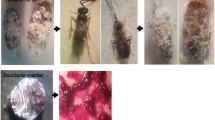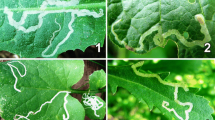Abstract
The percentage parasitism ofSaissetia nigra (Nietner) by chalcidoid parasites and the relative abundance of individual parasites were studied in the field usingHibiscus rosa-sinensis L. as the host plant. In order of abundance (on the basis of percentage recorded) the primary parasites wereAnysis saissetiae Ash.,Aneristus ceroplastae How., andMicroterys newcombi (Gir)., while the hyperparasites wereMarietta exitiosa Comp.,Cheiloneurus saissetiae Noyes & Chua andEupelmus catoxanthae Ferr. The efficiency ofA. saissetiae (the larvae of which feed on the scale eggs) to control the scale population is doubtful because it is often parasitised by all 3 hyperparasites mentioned and each larva during development causes only 58% egg mortality of the parasitised host, leaving many scale eggs unconsumed.A. ceroplastae appears to be more useful parasite because it attacks the 2nd instar scales which cause significant damage to the host plant and it is free from attack by hyperparasites.
Résumé
Utilisant l'Hibiscus rosa-sinensis comme plante réceptrice, nous avons procédé à l'étude sur le terrain du taux de parasitisme duSaissetia nigra (Nietner) par les parasites chalcidoides, d'une part, et de l'abondance relative des parasites pris individuellement, d'autre part. Par ordre d'importance numérique (sur la base des pourcentages enregistrés) nous trouvons parmi les parasites primaires:Anysis saissetiae Ash,Aneristus ceroplastae How., etMicroterys newcombi Gir, et parmi les hyperparasites:Marietta exitiosa Comp,Cheiloneurus saissetiae Noyes & Chua etEupelmus catoxanthae Ferr. La capacité deA. saissetiae (dont la larve se nourrit des œufs de cochenille) à limiter la population de cochenille reste hypothétique étant donné qu'il est souvent parasité lui-même par ces 3 hyper-parasites et que chaque larve, au cours de son développement, ne détruit que 58% des œufs de l'hôte, laissant subsister un grand nombre d'œufs intacts.A. ceroplastae, de ce point de vue, est un parasite beaucoup plus efficace: il attaque les cochenilles au 2e stade, cause principale des dégâts et ne subit pas les attaques des hyper-parasites.
Similar content being viewed by others
References
Annecke, D. P. &Insley, H. P. — 1971. Catalogue of EthiopianEncyrtidae andAphelinidae [Hymenoptera: Chalcidoidea] —Entomol. Mem. Dep. Agric. Tech. Serv. Report. S. Afr., 23, 1–53.
Anonymous — 1968. Scale insects, mealy bugs and lac insects. —Plts. Bull. Rubb. Res. Inst. Malaya., 98, 146–152.
Chua, Tock Hing — 1972. Studies on the chalcidoid parasites [Hymenoptera] ofSaissetia nigra (Nietner) andS. coffeae (Walker) [Coocidae: Homoptera]. —M. Sc. Thesis, Univ. Malaya, Kuala Lumpur, Malaysia.
Chua, Tock Hing — 1976. The chalcidoid parasites of the scale insectsSaissetia nigra (Nietner) andS. coffeae (Wlk.) in Malaysia —Malay. Nat. J., 29, 134–146.
Flanders, S. E. — 1942. Biological observations on the citricola scale and its parasites. —J. Econ. Entomol., 35, 830–837.
Flanders, S. E. — 1953. Variations in susceptibility of citrus-infesting coccids to parasitisation. —J. Econ. Entomol., 46, 266–269.
Flanders, S. E. — 1959a. Biological control ofSaissetia nigra (Niet.) in California. —J. Econ. Entomol., 52, 596–600.
Flanders, S. E. — 1959b. The employment of exotic entomophagous insects in pest control. —J. Econ. Entomol., 52, 71–75.
Flanders, S. E. — 1966. The circumstances of species replacement among parasitic Hymenoptera. —Can. Entomol., 98, 1009–1024.
Nikolskaya, M. N. — 1952. The chalcid fauna of the U.S.S.R. —Opred. Faune. S.S.S.R. 44, 575 pp. (English translation).
Noyes, J.S. &Chua, T.H. — 1977. Descriptions of two new species ofCheiloneurus Westwood from Malaysia [Hymenoptera: Encyrtidae]. —Orient. Insects, 11, 77–81.
Peck, O. — 1963. A catalogue of the NearcticChalcidoidea [Insecta: Hymenoptera]. —Can. Entomol. Suppl., 30, 1092 pp.
Rao, B. S. — 1965. Pests of Hevea plantations in Malaya. —Rubber Res. Inst., Kuala Lumpur, Malaya. 98 pp.
Smith, R. — 1944. Bionomics and control of the nigra scale,Saissetia nigra. —Hilgardia, 16, 225–286.
Teo, L. H. — 1968. Studies on the morphology and general biology ofSaissetia hemisphaerica (Targioni-Tozzeti) andSaissetia nigra (Nietner) [Hymeopter-Coccidae]. —Zool. Hon. Thesis, Univ. Malaya, Kuala Lumpur, Malaysia.
Yasumatsu, K. &Yoshimura, S. — 1945. Some chalcidoid parasites ofSaissetia nigra andS. hemisphaerica in Micronesia [Hymenoptera]. —Mushi, 16, 29–34.
Yunus A. &Ho, Thian Hua — 1970. Host-parasitie/predator list (1920–70). —Minist. Agric. Co-op., Malaysia. 362 pp.
Zimmermann, E. C. — 1948. Insects of Hawaii. Vol. 5:Homoptera: Sternorhyncha. —Univ. Howaii Press, Honolulu, 464 pp.
Author information
Authors and Affiliations
Rights and permissions
About this article
Cite this article
Chua, T.H. The parasite complex ofSaissetia nigra in Malaysia. Entomophaga 23, 195–201 (1978). https://doi.org/10.1007/BF02371728
Issue Date:
DOI: https://doi.org/10.1007/BF02371728




